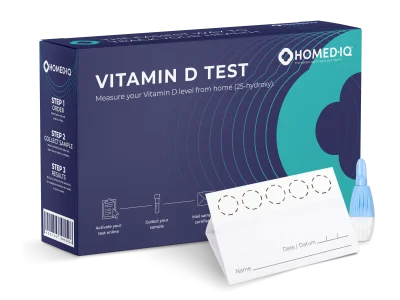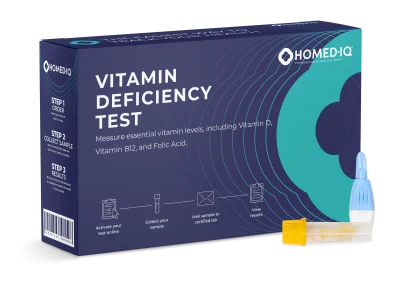Often referred to as the “sunshine vitamin”, vitamin D is an essential nutrient that plays a key role in a variety of bodily functions. Although our bodies can make vitamin D through exposure to sunlight, it is also found in certain foods. Have you ever wondered if you are consuming enough of this important nutrient? A deficiency can have far-reaching effects on our health. Read on to learn more about the importance of vitamin D for your well-being.
What is Vitamin D?
Vitamin D is a fat-soluble vitamin that plays a role in calcium and phosphate absorption in the body. Most vitamin D is produced by the human body itself. This happens when your skin is exposed to UV rays from the sun. In this case, vitamin D3 is produced. Vitamin D3 is also found in a number of foods of animal origin. Vitamin D2 is formed in certain mushrooms and fungi.
Vitamin D plays an important role in your body. It ensures the growth and maintenance of strong bones and teeth, ensures the functioning and recovery of your muscles, and promotes proper functioning of your immune system.
What are good sources of vitamin D?
Vitamin D is largely produced when your skin is exposed to UV radiation from the sun. There are also certain foods that contain this vitamin, such as herring, salmon, mackerel, sardines in oil, and salmon. In addition, vitamin D occurs naturally in butter, avocado, meat, and eggs. In the Netherlands and several other European countries, vitamin D is added to margarine and low-fat margarine. Fish oils, like cod liver oil, also contain high amounts of vitamin D. Finally, vitamin D is available as a supplement at drugstores (Thuisarts, 2022).
Good sources of vitamin D:
- Sunlight (UV radiation)
- Fatty fish
- Avocado
- Egg
- Meat
- Butter, margarine, low-fat margarine
- Supplements
Why is vitamin D important?
Vitamin D is essential to several bodily processes. For example, it ensures the maintenance of strong bones and teeth and promotes their growth in children. Vitamin D also helps to limit bone loss in order to reduce the risk of osteoporosis later in life. In addition, vitamin D plays a role in the functioning and recovery of muscles. It also has a positive influence on the functioning of the immune system.
What is a normal vitamin D value?
A good vitamin D value differs by age group (Nederlands Huisartsen Genootschap, 2018):
- 30 to 50 nmol/l: 0-4 years
- 50-75 nmol/l: 5 -64 years
- 75-100 nmol/l : > 65 years
Can you vitamin D level be too high or too low?
Vitamin D can be either too high or too low. If it is too high, it usually means an individual has been taking vitamin D supplements for a extended period of time. It is very rare that someone would have excessive vitamin D levels from diet or sun exposure alone.
Do I need extra vitamin D?
Most children and adults do not need extra vitamin D. Yet there are groups that do benefit from this (Dutch Journal of Medicine, 2012):
- Children from 0 to 4 years. Many children in this age group do not get enough vitamin D from their diet. In addition, it is advised to protect young children as much as possible from the sun. Therefore, a daily supplement of 10 micrograms is recommended.
- Children and adults between the ages of 4 and 69 who have dark/tan skin that do not get enough sun during the day or wear clothing that covers their skin. A daily supplement of 10 micrograms is also recommended for this group.
- Women between the ages of 50 and 69. The advice of an extra 10 micrograms per day also applies here, as this improves bone density.
- Pregnant women. Sufficient vitamin D is extra important for this group. A deficiency can not only be detrimental to the woman, but also have serious consequences for a developing baby.
- Anyone 70 years and older. An extra 10 to 20 micrograms of vitamin D per day protects against bone fractures. Fair-skinned elderly people who get outside often can consume 10 micrograms per day.
How does a vitamin D deficiency develop?
Vitamin D deficiency occurs mainly when there is too little UV radiation exposure to the skin. In addition, people with darker skin are less likely to produce vitamin D through exposure to sunlight. This is also the case with older people. Other groups at risk of vitamin D deficiency are young children, who usually do not yet get enough vitamin D from their diet and who are often well protected from the sun.
Is a Vitamin D Deficiency dangerous?
A vitamin D value that is too low means that calcium and phosphorus from foods are no longer properly absorbed into your body. This has a negative influence on bone development, muscle development, maintenance of strong bones and maintenance of muscles. In addition, a vitamin D value that is too low may cause your immune system to function less well. If the value is too low, there is a risk of rickets in children and osteoporosis in adults (Nutrition Centre).
Are there any diseases related to vitamin D deficiency?
There are several diseases related to vitamin D deficiency, such as bone loss or osteoporosis. During osteoporosis there is an increased risk of bone fractures. Women after menopause who are especially prone to osteoporosis. In children, a deficiency of vitamin D can disrupt the process of bone building. This may result in bone fractures, or even bone deformity. This condition is known as rickets and fortunately is virtually non-existent in the Netherlands. This is partly because vitamin D is added to infant formula in the Netherlands on the basis of an EU directive. A daily supplement in the form of vitamin D drops is also recommended for children up to 4 years of age.
How can I improve my vitamin D intake?
If your vitamin D level is too low, it is first of all important to let more sunlight reach your skin. Try to spend at least fifteen to thirty minutes in the open air every day, preferably between 11:00 and 15:00 (Thuisarts, 2022). It is also recommended to eat oily fish once or twice a week and to eat other foods that contain vitamin D. It is also possible to take vitamin D supplements daily, such as in the form of tablets, capsules or drops.
How long does it take for vitamin D deficiency to be reversed?
The time it takes for a vitamin D deficiency to be reversed varies from person to person. On average, this takes three to six months. The greater the deficiency you have incurred, the longer it will take you to recover from it.
When should you test your vitamin D level?
There are a number of reasons that may prompt a vitamin D test. For example, if there is a higher risk of a vitamin D deficiency, such as in elderly, people with dark skin, vegans, vegetarians, or during pregnancy. It is also good to test the vitamin D levels if you have an unhealthy diet or engage in excessive alcohol consumption. This also applies to people on a fat-free or low-fat diet, and to anyone who doesn’t go outside much. It is also advisable to have your vitamin D level tested if you suffer from symptoms that could be related to vitamin D deficiency, such as weakness, depression, fatigue, aching joints, or muscle pain.
Vitamin D testing
Vitamin D levels can be measured using a blood test. This can be done at a doctor’s office, blood testing clinic, or using a home test. Homed-IQ’s Vitamin D Test requires a finger prick blood sample that can be taken from home. After collecting your sample, simply mail the test kit to one of Homed-IQ’s certified laboratories, who will examine the test and will share the results within a few days.
-

Vitamin D Test
€45,00 -

Vitamin Deficiency Test
€65,00
Is Homed-IQ’s vitamin D test reliable?
Yes- all Homed-IQ tests are processed and analyzed in a certified laboratory. The laboratories we work with are also used by hospitals, general practitioners and other medical specialists.
Is this vitamin D test an alternative to a blood test from the doctor?
A blood test for vitamin D via the GP is carried out in exactly the same way as the Homed-IQ home test. The difference is that you collect the sample at home, allowing you to take the test anonymously, from the comfort of your own home, and at a time of your choosing.
How does the Homed-IQ vitamin D test process work?
Homed-IQ’s test process is very simple. First, you must collect the blood sample via a finger prick. Then, use the supplied transport bag and the return envelope to send your sample to the lab. Your results will be ready within a few days.
References
Ik heb misschien extra vitamine D nodig | Thuisarts.nl. (2022, February 4). Thuisarts. https://www.thuisarts.nl/vitamine-d/ik-heb-misschien-extra-vitamine-d-nodig#hoe-kom-ik-aan-vitamine-d
Laboratory diagnostics. (2021, June). NHG Guidelines. https://richtlijnen.nhg.org/landelijke-eerstelijns-samenwerkingsafspraken/laboratoriumdiagnostiek#volledige-tekst-vitamine-d-deficintie
Voedingscentrum. (n.d.). Vitamine D. https://www.voedingscentrum.nl/encyclopedie/vitamine-d.aspx#:~:text=Voor%20iedereen%20geldt%20een%20aanbevolen,via%20de%20zon%20en%20voeding.
Weggemans, R. M., Kromhout, D., & Van Weel, C. (2012, November 20). Gezondheidsraadadvies: nieuwe voedingsnormen voor vitamine D. NTvG. https://www.ntvg.nl/artikelen/gezondheidsraadadvies-nieuwe-voedingsnormen-voor-vitamine-d






